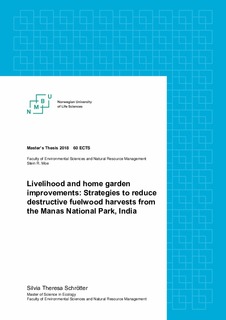| dc.contributor.advisor | Moe, Stein R. | |
| dc.contributor.advisor | Gross, Eva | |
| dc.contributor.author | Schrötter, Silvia Theresa | |
| dc.coverage.spatial | India | nb_NO |
| dc.date.accessioned | 2018-11-20T13:15:27Z | |
| dc.date.available | 2018-11-20T13:15:27Z | |
| dc.date.issued | 2018 | |
| dc.identifier.uri | http://hdl.handle.net/11250/2573996 | |
| dc.description.abstract | Fuelwood is the primary energy source for cooking in rural India. Natural forests in protected areas are often accessed by local people to collect this resource. However, the extraction of wood destructs forests, threatens species diversity and may lead to a loss of ecosystem functions. An approach to reduce the anthropogenic pressure on protected areas is to replace the amount of fuelwood harvested from natural forests with fuelwood obtained from alternative sources like home gardens. The aim of the study was to find out, if the livelihoods of local people could be improved and, if home gardens had the potential to function as substituting fuelwood sources, in order to reduce the extraction of fuelwood harvested from the Manas National Park (MNP) in Assam, India. Furthermore, it was investigated how the amount of fuelwood obtained from home gardens could be increased and, if the extent of the dominant cash-crop areca palm (Areca catechu) had a decreasing impact on the fuelwood supply by home gardens. Socio-economic household interviews were conducted, and the size of home gardens, as well as an inventory of potential fuelwood trees and of areca palms in home gardens was analyzed. Fuelwood harvests from the MNP decreased with the degree of education of household members and the access to an electric power source. Assamese people encroached the MNP to extract fuelwood more, than members of the aboriginal Bodo tribe. Households located closer to the nearest entry of the MNP, had a higher probability to procure fuelwood from the MNP, compared to households further away from the park. The more fuelwood was procured from home gardens, the less likely it was for households to rely on fuelwood obtained from the MNP. The proportion of fuelwood harvested from home gardens increased with the existing fuelwood stock and with the size of home gardens. The extent of the dominant monocultured areca palm (Areca catechu) did not have a negative effect on the amount of fuelwood supplied by home gardens. This study shows that the degradation of the MNP could be reduced by improving the livelihoods of local people through providing electricity and enhancing the general education. Conservation strategies like afforestation actions could increase the fuelwood stocks in home gardens and conservation education could raise community awareness towards the MNP and towards the potential of private fuelwood stocks. | nb_NO |
| dc.language.iso | eng | nb_NO |
| dc.publisher | Norwegian University of Life Sciences, Ås | nb_NO |
| dc.rights | Attribution-NonCommercial-NoDerivatives 4.0 Internasjonal | * |
| dc.rights.uri | http://creativecommons.org/licenses/by-nc-nd/4.0/deed.no | * |
| dc.subject | fuelwood collection | nb_NO |
| dc.subject | Sustainable livelihood | nb_NO |
| dc.subject | Protected area conservation | nb_NO |
| dc.subject | Bodo tribe | nb_NO |
| dc.subject | Agroforestry | nb_NO |
| dc.subject | Community based conservation | nb_NO |
| dc.title | Livelihood and home garden improvements : strategies to reduce destructive fuelwood harvests from the Manas National Park, India | nb_NO |
| dc.type | Master thesis | nb_NO |
| dc.description.version | submittedVersion | nb_NO |
| dc.description.localcode | M-ECOL | nb_NO |

